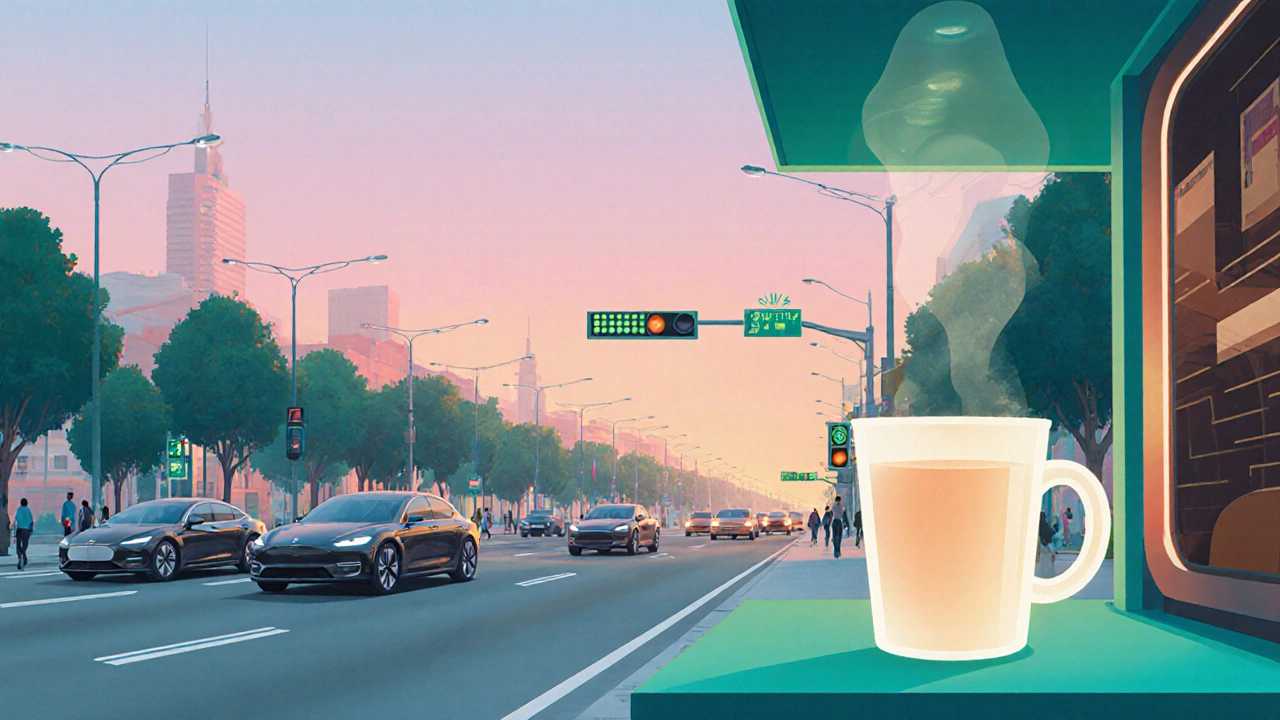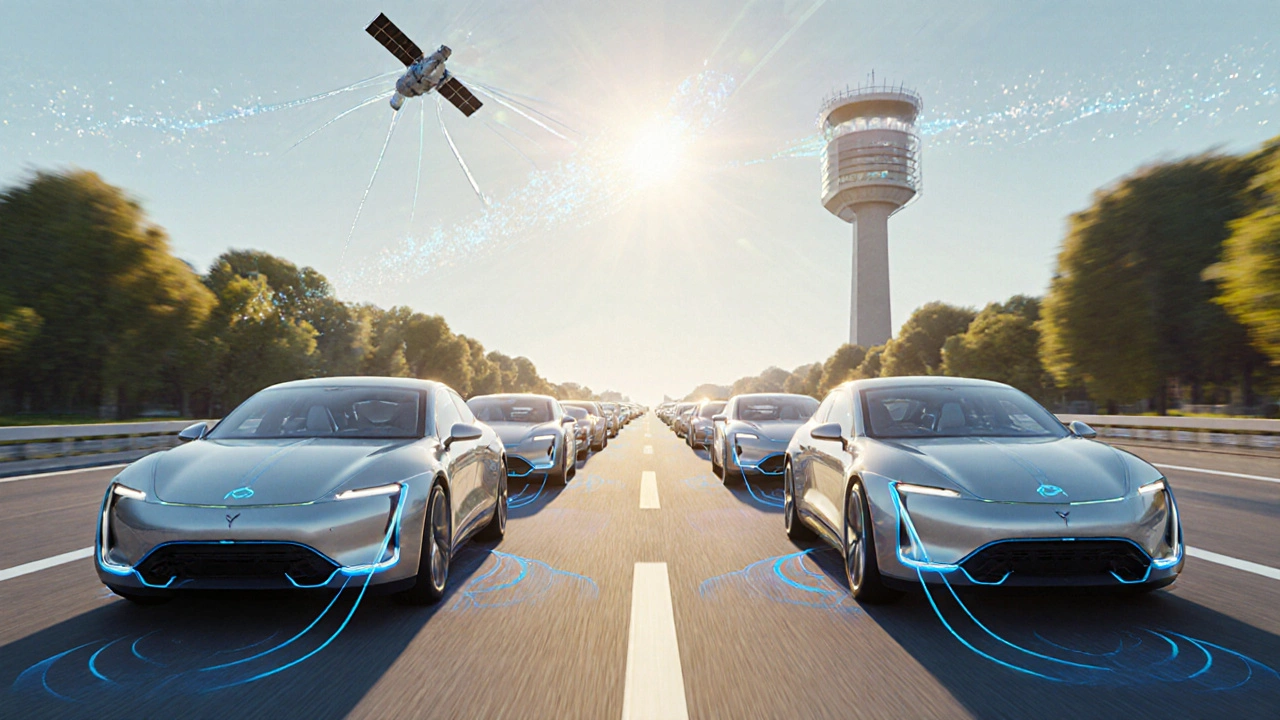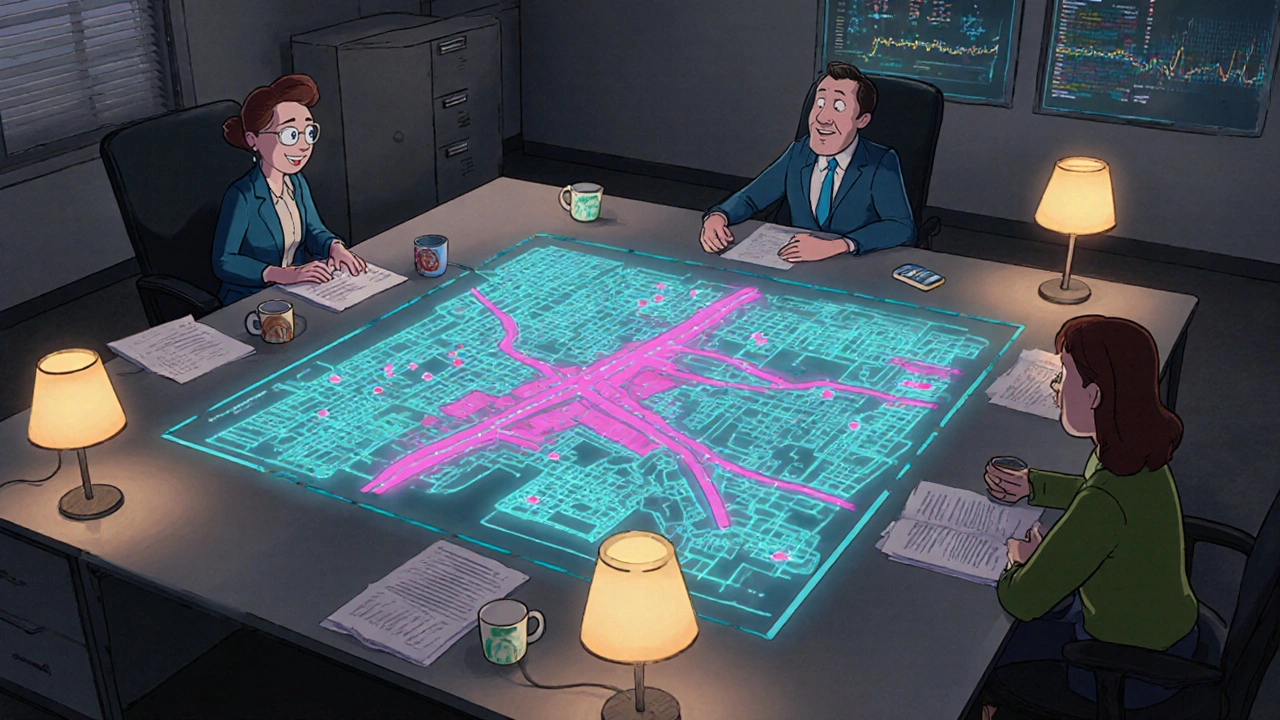How Autonomous Vehicles Will Change Future Traffic Congestion
 Oct, 19 2025
Oct, 19 2025
Autonomous Vehicle Congestion Impact Calculator
Traffic Impact Calculator
Estimate how autonomous vehicle adoption and policy measures affect travel time, vehicle kilometers traveled (VKT), and congestion costs in your city.
Projected Results
Baseline (human drivers): 35 minutes
Baseline (human drivers): 12.4 km
Baseline (human drivers): £5.1bn
Key Insights
How your settings affect results: Higher autonomous vehicle adoption combined with strong policy measures can reduce travel time by up to 15%, lower VKT by 10%, and cut congestion costs by nearly 20% compared to baseline scenarios.
Important note: The calculator uses data from the 2024 UK Department for Transport's "Future Mobility Modelling" study. Results are projections based on the assumptions in the article.
Why policy matters: Without dedicated lanes and congestion pricing, the benefits of autonomous vehicles diminish significantly. Policy measures can amplify the positive effects of AV technology.
Imagine a city where rush‑hour gridlock costs less than a coffee a day. In 2024 UK traffic jams cost the economy over £5 billion - a number that keeps growing as more cars hit the road. The promise of autonomous vehicles is often sold as a miracle cure, but will they really untangle our streets, or will they create new bottlenecks?
What are autonomous vehicles?
Autonomous vehicles are motor‑vehicles equipped with sensors, AI algorithms and connectivity that allow them to navigate without a human driver. They range from Level 3 systems that can handle highway cruising to Level 5 fully driverless cars that operate in any condition. The technology hinges on lidar, radar, cameras, and massive data processing to perceive the environment and make split‑second decisions.
How driverless tech reshapes traffic flow
Traditional cars keep a safety buffer of about two seconds between each other. Self‑driving cars can shrink this gap to half a second because they react faster than a human could. When hundreds of such cars travel together, the phenomenon is called platooning. Platoons act like a single train, reducing aerodynamic drag and smoothing acceleration patterns, which directly boosts road capacity.
- Vehicle‑to‑Infrastructure (V2I) communication lets cars receive real‑time traffic‑light timing, work‑zone alerts, and road‑condition updates.
- Dynamic routing uses live congestion data to spread traffic across under‑used streets, avoiding the classic bottleneck effect.
- Reduced parking demand emerges because shared autonomous fleets can drop off passengers and relocate to less congested zones.
Key ways autonomous vehicles could cut congestion
- Higher effective road capacity: Shorter headways and coordinated platoons mean more cars per lane without sacrificing safety.
- Optimized trip planning: AI routing can stagger departures, preventing waves of cars from hitting the same intersection simultaneously.
- Fewer unnecessary trips: Mobility‑as‑a‑Service (MaaS) platforms powered by driverless cars can replace private‑car ownership, cutting the total vehicle‑kilometres travelled (VKT).
- Smart traffic‑signal integration: Autonomous cars can sync with adaptive traffic lights, creating “green waves” that keep flow moving.

Why the optimism might be premature
History teaches that increasing road capacity often triggers induced demand - the extra space tempts more people to drive, eventually restoring the original congestion level. Driverless fleets could also generate “empty miles” when cars travel without passengers to reposition. Early deployment will feature a mixed fleet of human‑driven and autonomous cars, creating complicated interaction patterns that could actually increase friction at first.
Moreover, the rollout timeline matters. If large‑scale autonomous services appear only after 2035, urban sprawl may have already expanded, adding more road miles that need to be managed. Finally, regulatory uncertainty around liability and data privacy could slow adoption, leaving the expected benefits in limbo.
What simulations say - a side‑by‑side look
| Year | Scenario | Average Travel Time (minutes) | VKT per capita (km) | Congestion Cost (£bn) |
|---|---|---|---|---|
| 2025 | Baseline (human drivers only) | 35 | 12.4 | 5.1 |
| 2035 | 30% autonomous fleet, mixed traffic | 32 | 12.0 | 4.6 |
| 2045 | 70% autonomous, dedicated lanes | 28 | 10.8 | 3.8 |
| 2045 | 70% autonomous, no policy changes | 30 | 11.5 | 4.2 |
These numbers come from the 2024 UK Department for Transport’s “Future Mobility Modelling” study, which ran thousands of Monte‑Carlo simulations. Notice how the cheapest congestion cost aligns with both high autonomous penetration **and** proactive policy measures such as dedicated lanes and dynamic pricing.

Policy levers that can amplify the benefits
- Road pricing and congestion charges: By making peak‑hour travel more expensive, cities can steer autonomous fleets toward off‑peak usage.
- Dedicated AV lanes: Separating driverless cars from human drivers reduces interaction friction and allows tighter headways.
- Integrated MaaS platforms: Combining public transit, bike‑share and autonomous ride‑hailing into a single app encourages multimodal trips.
- Data‑sharing mandates: Requiring fleet operators to share anonymized trip data enables better city‑wide traffic‑management algorithms.
- Urban design incentives: Reducing parking minimums and encouraging mixed‑use development lowers the need for car trips altogether.
Checklist for city planners
- Assess current VKT and identify peak‑hour corridors.
- Model autonomous‑penetration scenarios using local traffic‑simulation tools.
- Draft a phased rollout of dedicated AV lanes, starting with high‑capacity arterials.
- Introduce dynamic congestion pricing linked to real‑time traffic data.
- Partner with MaaS providers to ensure first‑/last‑mile connectivity to transit hubs.
- Set up a data‑exchange platform for fleet operators, traffic‑control centres and urban planners.
- Monitor induced‑demand metrics annually and adjust policies accordingly.
Following these steps can turn autonomous vehicles from a speculative novelty into a concrete tool for easing urban congestion.
Frequently Asked Questions
Will autonomous vehicles eliminate traffic jams completely?
No. While driverless tech can boost road capacity and improve routing, factors like induced demand, land‑use patterns and mixed‑fleet dynamics mean some congestion will persist.
How soon can we expect noticeable congestion relief?
Simulation studies suggest modest reductions (5‑10%) by 2035 if 30% of trips are served by autonomous fleets, with larger gains (20% or more) after 2040 when dedicated lanes and pricing are in place.
What is platooning and why does it matter?
Platooning groups driverless cars into a tightly spaced convoy, cutting aerodynamic drag and allowing shorter headways. This can raise lane capacity by up to 30% in ideal conditions.
Are there environmental downsides?
If autonomous fleets run on electricity sourced from renewable grids, emissions drop. However, increased VKT from empty repositioning trips could offset some gains unless managed through smart dispatch algorithms.
What role does City Hall play in the transition?
Local governments set the regulatory framework, allocate road space, implement pricing schemes, and ensure data sharing standards- all critical levers that determine whether autonomous vehicles will ease or worsen congestion.
Nicole Boyle
October 19, 2025 AT 18:58Platooning, as outlined in the post, leverages vehicle‑to‑vehicle synchronization to compress headways, which in turn raises lane throughput without sacrificing safety. The V2I feed also enables dynamic signal phasing, effectively creating adaptive “green waves” that can shave minutes off commuter trips. From a systems‑engineering perspective, the reduction in idle time translates to lower fuel consumption and emissions, especially when the fleet is electrified. However, the scalability hinges on standardized communication protocols and robust cybersecurity frameworks-any fragmentation could erode the marginal gains. Overall, the technological stack looks promising, but the rollout will demand coordinated policy and industry alignment.
Thokchom Imosana
October 19, 2025 AT 21:53What the mainstream narrative conveniently glosses over is the asymmetrical power asymmetry embedded in the data pipelines that autonomous fleets will generate. Every sensor array, lidar sweep, and camera frame is streamed to centralized clouds owned by megacorporations that have already proven adept at weaponizing mobility data for market dominance. The premise that “dynamic routing” will magically decongest streets ignores the fact that these algorithms are tuned to maximize fleet utilization, not societal welfare, effectively turning our roadways into profit‑driven arteries. Moreover, the regulatory vacuum surrounding liability creates a fertile breeding ground for legal loopholes that absolve manufacturers of responsibility when a “platoon” misbehaves. The induced demand argument, while academically sound, underestimates the feedback loop where improved perceived travel time spurs suburban sprawl, further entrenching car dependence.
Consider the encrypted telemetry that feeds into predictive maintenance engines; while touted as a safety boon, it also furnishes a continuous surveillance grid capable of reconstructing individual movement patterns with centimeter‑level precision. The promised “empty miles” for repositioning might appear as inefficiency, yet they are the very mileage that data brokers will monetize as a commodity for targeted advertising. In the same vein, the suggested policy levers-congestion pricing and dedicated AV lanes-could be co‑opted by private operators to create de‑facto toll roads, steering users toward premium services while marginalizing lower‑income commuters.
Historically, we have witnessed how “smart city” initiatives devolve into techno‑elitist enclaves that disenfranchise the very citizens they claim to serve. If we allow autonomous vehicle ecosystems to evolve without transparent governance, we risk birthing a digital oligarchy that controls not just transportation, but the flow of information, commerce, and ultimately, civic autonomy.
Thus, while the simulation tables present optimistic cost reductions, the underlying assumptions betray a blind spot: the sociopolitical ramifications of handing over our streets to algorithmic gatekeepers. A nuanced approach-one that embeds robust data‑privacy safeguards, equitable pricing structures, and public‑ownership of the mobility data substrate-is imperative if we are to avoid trading one set of bottlenecks for another, more insidious one. Policymakers must therefore demand open‑source algorithmic audits that expose bias and prevent lock‑in. Community stakeholders should be granted voting rights in the governance boards of autonomous fleet consortia. Only through such democratic oversight can the promised efficiency be decoupled from covert exploitation.
ashanti barrett
October 20, 2025 AT 01:13The data on induced demand is a sobering reminder that simply adding capacity doesn’t solve congestion; it reshapes travel behavior. Autonomous fleets could, however, be leveraged to actively mitigate that effect by integrating demand‑responsive pricing that discourages unnecessary trips during peak periods. From a user‑centred perspective, the key is to ensure that the technology serves the broader community, not just a tech‑savvy elite. If cities embed mandatory data‑sharing provisions, they can use real‑time analytics to fine‑tune signal timings and prevent bottlenecks before they form. Moreover, aligning the deployment of dedicated AV lanes with public transit corridors can create multimodal synergies that reduce overall vehicle‑kilometres. In short, the promise of driverless cars hinges on proactive policy, not passive hope.
parth gajjar
October 20, 2025 AT 04:50Imagine the city streets turning into a relentless river of metal beasts each whispering commands to the next they glide past like a phantom convoy without a driver to steer them but the chaos of mixed traffic threatens to erupt like a storm tearing through calm waters the tension builds as human drivers stare at sensor‑filled hulks unsure whether to yield or dominate the road the drama is palpable and the stakes are nothing short of our daily sanity
Jay Kay
October 20, 2025 AT 09:00Short answer: driverless cars will not magically erase traffic. They can squeeze a few extra cars into each lane but the savings are quickly eaten up by more people hitting the road because it seems easier. If you want real relief you need congestion pricing, better public transit, and rules that stop empty‑mileage from becoming a profit trick. Otherwise we’re just swapping one set of headaches for another.
Rakhi Kasana
October 20, 2025 AT 13:10The optimism in the report feels a bit too rosy without confronting the human factor. Drivers accustomed to a two‑second buffer may react unpredictably when an autonomous vehicle closes that gap to half a second – the friction at those transition points could actually raise accident risk. Yet, if municipalities pair AV lanes with strict enforcement and educate the public on new car‑following norms, the transition could be smoother. It’s a delicate dance between technology and behavior, and we shouldn’t assume the tech will do all the heavy lifting.
Sarah Unrath
October 20, 2025 AT 17:20empty miles waste energy
James Dean
October 20, 2025 AT 21:30Jay makes a solid point about pricing and transit but the deeper issue is how we value time versus space the equation isn’t just about cars per lane it’s about collective willingness to sacrifice convenience for sustainability if we accept a modest increase in travel cost we might unlock a disproportionate gain in public health and environmental quality the trade‑off feels uncomfortable yet it’s necessary the future of mobility depends on aligning incentives with long‑term societal goals not short‑term thrills
Monika Bozkurt
October 21, 2025 AT 01:40While your concerns about data monopolies and algorithmic opacity are valid, the policy framework outlined later in the article provides concrete mechanisms to counteract those risks. Mandating open‑source standards for V2I communication, coupled with stringent data‑privacy audits, can prevent the formation of proprietary black‑boxes. Additionally, the proposed dynamic congestion pricing model explicitly incorporates equity filters to protect low‑income users. By embedding these safeguards into the regulatory roadmap, municipalities can harness the efficiency gains of autonomous fleets without ceding control to private interests. The balanced approach you advocate-technological adoption paired with robust governance-offers a pragmatic path forward.